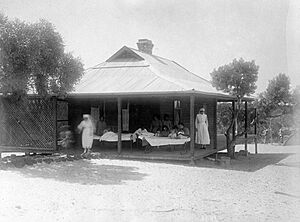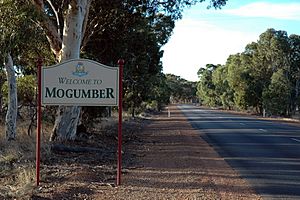Moore River Native Settlement facts for kids
The Moore River Native Settlement was a place in Western Australia where many Aboriginal Australians were forced to live. It was like a camp located about 135 kilometers (84 miles) north of Perth, near the start of the Moore River. This settlement operated for many years and had a big impact on the lives of thousands of Aboriginal people.
Contents
History of the Settlement
The government of Western Australia opened the Moore River Native Settlement in 1918. At first, it was meant to be a small farm where about 200 Aboriginal people could live and work. The idea was to provide schooling and healthcare for children and jobs for adults. It was planned for Aboriginal people mainly from the Murchison, Midlands, and south-west areas of Western Australia.
However, the land was not good for farming, so the idea of a self-supporting farm failed. During the 1920s, the settlement's purpose changed. People were often brought there against their will. It became a place for orphans, young children, older people, single mothers, and those who were unwell. Many children of mixed Aboriginal and non-Aboriginal heritage were also sent there. These children were often taken from their families and homes, usually without their parents' permission. This was part of a sad time in Australian history known as the Stolen Generations.
The Moore River Native Settlement was managed by the Chief Protector of Aborigines, A. O. Neville. He had no experience working with Aboriginal people. Neville was strongly influenced by Rufus Henry Underwood. Together, they created a plan for "native settlements." This plan aimed to separate Aboriginal people from the wider community. It also ensured that Aboriginal people would still be available for labor. Neville and Underwood wanted to do all this with very little money.
Key Dates for Moore River
| Year | Event |
|---|---|
| 1905 | The Aborigines Act was passed in Western Australia. |
| 1915 | A. O. Neville became the Chief Protector of Aborigines. |
| 1917 | The government decided to establish the Moore River Native Settlement. |
| 1918 | The first people arrived at the settlement. |
| 1929 | The Great Depression began, affecting many people. |
| 1933 | People from Northam were forcibly moved to the settlement. |
| 1934 | The Mosely Royal Commission investigated how Aboriginal people were treated. |
| 1936 | Changes were made to the Aborigines Act based on the commission's findings. |
| 1940 | A. O. Neville retired from his position. |
| 1950 | Plans began to hand over the settlement to the Methodist Church. |
| 1951 | The settlement became the Mogumber Native Mission. |
| 1967 | A national vote (referendum) allowed Aboriginal people to be counted in the Australian census. |
| 1974 | The settlement officially closed. |
Difficult Living Conditions
The people living at Moore River came from many different parts of Western Australia. Some traveled from as far away as the Kimberley and Pilbara regions. By the mid-1920s, conditions at the settlement became very bad. It was often overcrowded, and there were serious problems with hygiene and cleanliness. Many health issues were reported among the people living there.
From 1924, the settlement usually had about 300 people, and its buildings were falling apart. By 1933, the Aboriginal population grew to over 500, making the conditions even worse. Between 1918 and 1952, 346 deaths were recorded at Moore River. Sadly, 42% of these deaths were children aged between one and five years old.
Life at Moore River Native Settlement was very strict. Boys and girls were kept separate, and children were often separated from their parents. They lived in dormitories. People living in the camp were not allowed to leave without written permission. Many tried to run away to reunite with their families outside the settlement. To stop this, some Aboriginal men were hired as trackers to find those who had escaped.
Name Change and Closure
In 1951, the government gave control of the settlement to the Mogumber Methodist Mission. They renamed it the Mogumber Native Mission. The new owners focused more on Christian teachings and on training young people for jobs. This was different from when it was run by the government.
The facility continued to operate until 1974. Then, it was taken over by the Aboriginal Land Trust. Today, the land is leased to the Wheatbelt Aboriginal Corporation and is known as Budjarra.
Stories and Media
Several plays, films, and books have been created that share the difficult stories of life in the Moore River Settlement:
- Aboriginal poet and playwright Jack Davis wrote a play called Kullark. In this play, an Aboriginal man named Thomas Yorlah is forced to move to the settlement and tries many times to escape. In another play by Davis, No Sugar, the entire Aboriginal community from Northam is sent to the settlement. Jack Davis himself lived in the settlement in the 1920s.
- The book Follow the Rabbit-Proof Fence by Doris Pilkington and its movie version (Rabbit-Proof Fence) tell the true story of three Aboriginal girls who ran away from the settlement in 1931.
- The book Broken Circles by Anna Haebich gives a detailed look at the experiences of the Stolen Generations.



